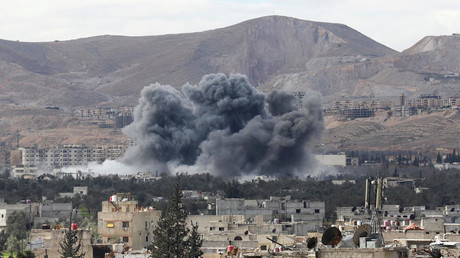Assad, Kim & chemical weapons: NYT ties in all the ‘villains’ in story on leaked UN report
What could be better to beat the drum for regime change than tying North Korean missiles to Syria and chemical weapons? Apparently, the New York Times did just that when it wrote about a leaked UN report.
The article, run by the respectable US newspaper on Tuesday, is based on a 200-page report by a group of eight experts who were tasked by the UN Security Council to monitor how sanctions against North Korea are implemented. The country was punished for developing nuclear weapons and rocket technology with serious restrictions on how it can trade with foreign nations and has been finding ways to circumvent those.
The NYT focused on two particular episodes mentioned in the report. One was the interception in January 2017 of two ships carrying acid-resistant tiles from North Korea to Syria, with three other such contracted shipments revealed via paper tracking, although whether or not they were actually made remains unclear. The UN experts said such tiles are “commonly used in the construction of chemical weapons factories.”
Another episode happened in August 2016, when a delegation of “North Korean missile technicians” visited Syria and brought with them “special resistance valves and thermometers known for use in chemical weapons,” according to the report. Both episodes were reported to the UN panel by unidentified UN personnel.
Experts who reviewed the report on behalf of the newspaper said the evidence presented by the UN “did not prove definitively that there was current, continuing collaboration between North Korea and Syria on chemical weapons.” The NYT did not say how or when it obtained the UN document, which is not available to the public.
The publication of the report comes as the Syrian government stands accused of repeatedly using chemical weapons against civilian targets in eastern Ghouta, a neighborhood of Damascus controlled by several jihadist groups. The alleged attacks with chlorine gas – which make little sense from the military point of view – are reported by local sources with ties to the militants. They cannot be verified by independent observers, including those from the countries openly calling for the toppling of the Syrian President Bashar Assad, like the US.
This does not stop the Western mainstream media from bombarding their audiences with reports of intolerable civilian suffering inflicted by the Russia-backed “Assad regime” and “experts” calling for a US-led military intervention against Damascus. With Assad presented as a contender to the title of the world’s top villain, adding Kim Jong-un of North Korea, another figure reviled in the West, would apparently bolster the bellicose narrative.
One may almost suspect that the US media have not learned their collective lesson from the run-up for the Iraqi invasion. Joseph Kahn, the managing editor of the New York Times, assured everyone last month that the coverage of the Iraqi WMDs was “an example of seriously flawed policy for political goal,” and that the paper has since made changes to editorial policy. We can now rest assured that the Syria coverage is a different story altogether.




0 Comments:
Post a Comment
Subscribe to Post Comments [Atom]
<< Home